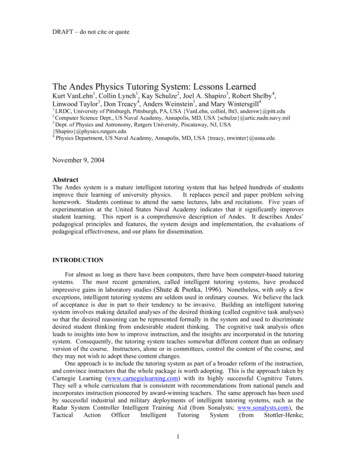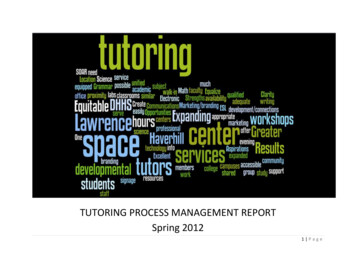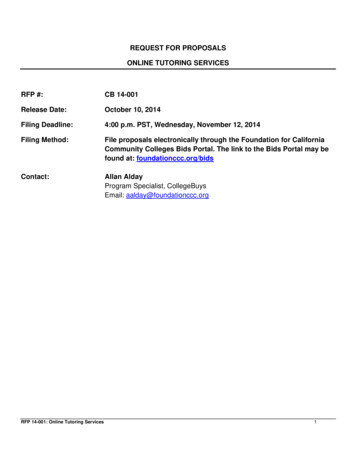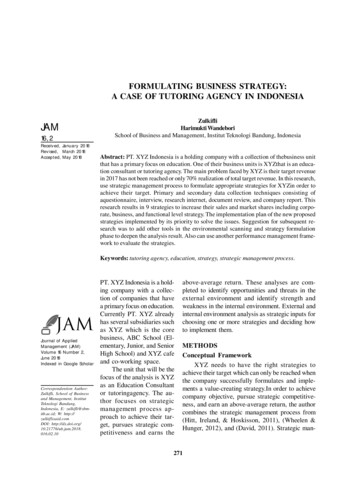
Transcription
DRAFT – do not cite or quoteThe Andes Physics Tutoring System: Lessons LearnedKurt VanLehn1, Collin Lynch1, Kay Schulze2, Joel A. Shapiro3, Robert Shelby4,Linwood Taylor1, Don Treacy4, Anders Weinstein1, and Mary Wintersgill41LRDC, University of Pittsburgh, Pittsburgh, PA, USA {VanLehn, collinl, lht3, andersw}@pitt.eduComputer Science Dept., US Naval Academy, Annapolis, MD, USA {schulze}@artic.nadn.navy.mil3Dept. of Physics and Astronomy, Rutgers University, Piscataway, NJ, USA{Shapiro}@physics.rutgers.edu4Physics Department, US Naval Academy, Annapolis, MD, USA {treacy, mwinter}@usna.edu2November 9, 2004AbstractThe Andes system is a mature intelligent tutoring system that has helped hundreds of studentsimprove their learning of university physics.It replaces pencil and paper problem solvinghomework. Students continue to attend the same lectures, labs and recitations. Five years ofexperimentation at the United States Naval Academy indicates that it significantly improvesstudent learning. This report is a comprehensive description of Andes. It describes Andes’pedagogical principles and features, the system design and implementation, the evaluations ofpedagogical effectiveness, and our plans for dissemination.INTRODUCTIONFor almost as long as there have been computers, there have been computer-based tutoringsystems. The most recent generation, called intelligent tutoring systems, have producedimpressive gains in laboratory studies (Shute & Psotka, 1996). Nonetheless, with only a fewexceptions, intelligent tutoring systems are seldom used in ordinary courses. We believe the lackof acceptance is due in part to their tendency to be invasive. Building an intelligent tutoringsystem involves making detailed analyses of the desired thinking (called cognitive task analyses)so that the desired reasoning can be represented formally in the system and used to discriminatedesired student thinking from undesirable student thinking. The cognitive task analysis oftenleads to insights into how to improve instruction, and the insights are incorporated in the tutoringsystem. Consequently, the tutoring system teaches somewhat different content than an ordinaryversion of the course. Instructors, alone or in committees, control the content of the course, andthey may not wish to adopt these content changes.One approach is to include the tutoring system as part of a broader reform of the instruction,and convince instructors that the whole package is worth adopting. This is the approach taken byCarnegie Learning (www.carnegielearning.com) with its highly successful Cognitive Tutors.They sell a whole curriculum that is consistent with recommendations from national panels andincorporates instruction pioneered by award-winning teachers. The same approach has been usedby successful industrial and military deployments of intelligent tutoring systems, such as theRadar System Controller Intelligent Training Aid (from Sonalysts; www.sonalysts.com), fromStottler-Henke;1
DRAFT – do not cite or .htm), or the Aircraft Maintenance Team Training(from Galaxy Scientific; 1.htm).Thedesigners work with subject matter experts to devise both improved content and a tutoring systemto go with it.However, getting instructors and institutions to adopted curricular reforms is notoriouslydifficult, with or without an accompanying tutoring system. Scientific evidence of greaterlearning gains is only part of what it takes to convince stakeholders to change.Moreover, the technology of intelligent tutoring systems does not in itself require contentreform. It should be able to aid learning of almost any content.The goal of the Andes project is to demonstrate that intelligent tutoring can be decoupledfrom content reform and yet still improve learning. This requires that Andes be minimallyinvasive. It should allow instructors to control the parts of the course that they want to control,and yet it should produce higher learning gains than ordinary courses.One task that instructors seem happy to delegate is grading homework. In recent years,many web-based homework (WBH) grading services have become available. Ones that servecollege physics courses (as does Andes) include WebAssign (www.webassign.com), MasteringPhysics (www.masteringphysics.com), CAPA (homework.phys.utk.edu), Homework Service(hw.utexas.edu/overview.html), OWL (ccbit.cs.umass.edu/owl), WebCT (www.webct.com),Blackboard (www.blackboard.com) and WWWAssign (emc2.acu.edu/ schulzep/wwwassign).These WBH services have students solve problems assigned by instructors, so the instructors stillhave control over that important feature of their courses. Students enter their answers on-line,and the system provides immediate feedback on the answer. If the answer is incorrect, thestudent may receive a hint and may get another chance to derive the answer.These services have grown rapidly. Thousands of instructors have adopted them.Universities have saved hundreds of thousands of dollars annually by replacing human graderswith these services (Dufresne, Mestre, Hart, & Rath, 2002). These trends suggest that unliketutoring systems, homework helpers will soon be ubiquitous. They are minimally invasive. Inparticular, they can be used with traditional classes as well as ones where only a small portion ofthe homework problems are traditional, because instructors can author their own homeworkactivities as well.However, the impact of WBH on learning is not clear. On the one hand, there are tworeasons why WBH might be better than paper-and-pencil homework (PPH). First, instructorsoften cannot afford to grade every PPH problem that they assign, so students may not do all theirassigned homework. With WBH, every problem is graded, and the homework grades often countin the student’s final grade, so students do more homework than they would with PPH. Thissuggests that WBH should produce more learning than PPH. Secondly, with WBH, studentsreceive immediate feedback on their answers, which might motivate them to repair theirderivations and hopefully the flaws in the knowledge that produced them. Of course, studentscould also look in the back of the book for the answers to some problems, but anyone who hasgraded homework knows that not all students do that, or if they do, they don’t bother to correcttheir mistakes.On the other hand, there is at least one reason why PPH might be better than WBH. WithWBH, students only enter answers and not the derivation of those answers. When humans gradePPH, they often score the derivations and, at least in physics courses, producing a well-structured,principled derivation usually counts more than getting the right answer. This grading practice isintended to get students to understand the physics more deeply. Of course, PPH students do notalways read the graders’ comments on their derivations, but the fact that they know theirderivations are being graded might motivate them to produce good ones anyway. Because theWBH systems cannot grade the student’s derivations, students might try less hard to producegood derivations and thus learn more shallowly than they would with PPH.2
DRAFT – do not cite or quoteClearly, experiments are needed that compare WBH with PPH. Although there are manystudies of WBH courses, they mostly report how the WBH service was used, the results ofquestionnaires, and correlations between WBH usage and learning gains. Only two studies ofphysics instruction have compared learning gains with WBH vs. PPH.In the first study (Dufresne et al., 2002), the same professor taught a PPH class and twoWBH classes in consecutive semesters. A subset of the exam problems were the same in all threeclasses, which allows them to be compared. One WBH class's mean exam score was 0.44standard deviations higher than the PPH class, but the other WBH class's mean exam score wasnot significantly different from the PPH class. However, a simple explanation for these resultsmay be that the PPH students didn’t do much homework. For the PPH class, most assignedhomework was not collected and graded, whereas for the WBH classes, all homework was scoredby the WBH service and the scores counted in the student’s final grade. Moreover, when studentsself-reported their homework times, the PPH student spent much less time than the WBHstudents. Of the PPH students, 62% said they spent less than 2 hours per week and 4% said theyspent more than 4 hours. Among students in the higher scoring WBH class, 11% reportedspending less than 2 hours, and 46% said they spent more than 4 hours. Thus, it is likely that thegains in the WBH class were due at least in part to the requirement that students hand inhomework, which resulted in them solving more problems, spending more time on task, andlearning more.In the second study (Bonham, Deardorff, & Beichner, 2003), all the PPH problems weregraded and the scores counted toward the student’s course grade. Students in several sections ofa calculus-based class received very similar homework assignments. Students in a PPH sectionand a WBH section of an algebra-base class received identical assignments. Dependent measuresinclude multiple-choice and open-response exam questions, and the Force and Motion ConceptsInventory (Thornton & Sokoloff, 1998). When SAT and GPA (grade point average) werefactored out, none of the measures showed a difference between PPH students and WBHstudents. This included a rather detailed scoring of the open-response exam questions designed todetect benefits of using PPH, where students were required to show all their work and weregraded more on the derivation than on the answer.This is moderately good news. The WBH answer-only format probably does not hurtstudents relative to the PPH format even though students only enter answers and not derivationswhen doing WBH. Perhaps WBH’s immediate feedback compensates for its answer-only format.Most importantly, WBH allows all assigned problems to be graded. Thus, when WBH iscompared to PPH courses that do not grade all assigned problems, WBH probably causes studentsto do more of their assigned problems and thus learn more.The goal of the Andes project is to retain the minimal invasiveness of WBH, but increase thelearning gains of students. The key idea is simply to have students enter their derivations just asthey do with PPH, but Andes gives immediate feedback and hints as each step is entered.Evaluations indicate that Andes homework has elicited more learning from students than PPH.This document describes how Andes behaves, its design and implementation, and its evaluations.A brief historyThe Andes project originated with an Office of Naval Research management initiative toforge close relationships between ONR and the Navy's academic institutions. In particular, therewas an interest in trying out artificially intelligent tutoring technology, a longstanding researcharea for ONR, at the Naval Academy. Dr. Susan Chipman of ONR supported a summersymposium series for interested Academy faculty in which many speakers from the intelligenttutoring research community spoke. Two projects resulted, an extensive implementation of KenForbus' existing CyclePad software in the thermodynamics curriculum at the Academy, and a3
DRAFT – do not cite or quotemore ambitious project to build a new physics tutor on the foundations of the Cascade and Olaeprojects, while also conducting research on issues of instructional strategies in intelligent tutors.Cascade was a rule-based cognitive model of physics problem solving and learning(VanLehn, 1999; VanLehn & Jones, 1993b, 1993c; VanLehn, Jones, & Chi, 1992). Itprovided one key ingredient of an intelligent tutoring system: a cognitive task analysis in the formof highly detailed rules that were capable of solving many physics problems in a variety ofcorrect and incorrect ways.Olae, which was built on top of Cascade’s cognitive model, was an on-line assessmentsystem (Martin & VanLehn, 1995a, 1995b; VanLehn & Martin, 1998; VanLehn & Niu,2001). It provided two more key ingredients: a graphical user interface and a student modelingmodule.In order to convert these ingredients into an intelligent tutoring system, we need to add twonew capabilities: feedback on student work and hints. Beyond these technical additions, theproject needed to include physics instructors who were dedicated to designing the tutoring systemand evaluating it in their classes. A team was assembled including the four Naval Academyprofessors listed above and a collection of post-docs, programmers and graduate students atLRDC, some of whom are listed above.1The main challenge was to create a minimally invasive tutoring system. Unlike the highlysuccessful intelligent tutoring projects at CMU (Anderson, Corbett, Koedinger, & Pelletier,1995; Koedinger, Anderson, Hadley, & Mark, 1997), the Andes project was not empoweredor interested in changing the curriculum significantly. The Andes instructors only taught aportion of the USNA physics course. Their sections had to use the same textbooks, same finalexams, similar labs and similar lectures as the non-Andes sections of the course. Thus, thechallenge was to improve student learning while coaching only the student’s homework. That is,the tutoring had to be minimally invasive. While challenging, we hoped that this would facilitateincorporating Andes into existing physics classes around the world.The first version, Andes1, was based on Olae’s student modeling technique. The techniqueused Bayesian networks to infer the probability of mastery of each rule. That is, a rule wasassumed to be in one of two states: mastered or unmastered. For a given student, the probabilityof the rule being in the mastered state reflected all the evidence that had been gathered so farabout this student’s behavior. Initially, all Andes1 knew about a student is that the student is amember of some population (e.g., US Naval Academy freshmen), and this established the priorprobability of each rule. As the student used Andes1, it noted which actions tended to be done bythe student, and this increased the probabilities on the rules that derived those actions. Foractions that could be done but were not, Andes1 gradually reduced the probability on the rulesthat derived those actions. The Bayesian networks handled these probabilistic calculationsefficiently and correctly.At the time, Andes1 was one of the first large scale applications of Bayesian networks, andarguably the first application of Bayesian networks to intelligent tutoring systems. The sametechnique was used in the Self-Explanation Coach (Conati & VanLehn, 2000; Conati &VanLehn, 2001) in order to assess rule mastery by observing which lines in a worked examplewere studied by students. As a pioneering application of Bayesian networks to student modeling,many technical challenges were discovered and surmounted. These hard-won results aredescribed in (Conati, Gertner, & VanLehn, 2002).Andes1 was evaluated twice at the Naval Academy, with strongly encouraging results. Onthe second evaluation, the mean post-test exam score of the students who did their homework on1Andes project “alumni” include Drs. Patricia Albacete, Cristina Conati, Abigail Gertner, Zhendong Niu,Charles Murray, Stephanie Siler, and Ms. Ellen Dugan.4
DRAFT – do not cite or quoteAndes was approximately 1 standard deviation higher than the mean exam score of students whodid the same homework with pencil and paper (Schulze et al., 2000). We could have stoppedthere, but we wanted to find out why Andes1 was so effective, and in particular, whether its novelstudent modeling technique was accurate and perhaps even partially responsible for its success.We conducted several studies to analyze the effectiveness of Andes1 (VanLehn et al.,2002; VanLehn & Niu, 2001). The bottom line was that the Bayesian student modelingtechnique was not the source of Andes1’s power. It was indeed a highly accurate assessment ofstudent mastery (VanLehn & Niu, 2001), but the rest of the tutoring system didn’t really havemuch use for such an assessment. Tutoring systems often use assessments to decide whichproblem a student should do next, or whether the student has done enough problems and can goon to the next chapter. However, Naval Academy students were assigned specific problems forhomework, so Andes did not need to select homework problems, nor was it empowered to decidewhether the student should go on to the next chapter. So Andes was creating an assessment, butnot using it to make the usual sorts of decisions one would make with such an assessment.The studies also reveal some significant pedagogical flaws in the hints given to students. Inorder to revise the hint system more easily, we eliminated the Bayesian networks while retainingthe non-probabilistic aspects of the student modeling module. We also incorporated two newmathematical algorithms that vastly improved the combinatorics and simplicity of the system(Shapiro, submitted). The new system, Andes2, also featured a new, more concise knowledgerepresentation and many other improvements, just as one would expect when redesigning aprototype from scratch.Andes2’s initial evaluation was promising, so we invested several years into scaling it up. Itnow covers most of the fall semester physics course (mostly mechanics) and about half the springsemester (mostly electricity and magnetism). At this writing, Andes has 356 problems which aresolved by a knowledge base of 550 physics rules.Within the last year, many “convenience” features were added, such as electronicsubmission of homework and automated problem scoring. These make Andes2 competitive withWBH grading services. Andes is now freely available, and may be downloaded or used as a webbased service (http://www.andes.pitt.edu).A preview of the paperIt is important to realize that unlike many of the articles, this one is not reporting tests of ahypothesis or a new technology. Granted, we had to invent some new technology en route, andthe evaluation of Andes is similar to the test of a hypothesis, but the ultimate purpose of theproject was to see if a minimally invasive tutoring technology could increase learning in realworld classes. Thus, most of what we learned in this process is applied knowledge: what willstudents and instructors accept; what kinds of hints work; which algorithms scale and which donot; how to conduct a fair field evaluation; etc. This article attempts to summarize what has beenlearned from this effort.The next section describes Andes2 from the point of view of the student—what it looks like,what it does and what role it plays in the physics course. The section after that describes thepedagogical features of Andes2, including both mundane ones and ones requiring AI. Thefollowing sections describe Andes’ technology and its evaluations. The last section summarizesthe lessons learned.THE FUNCTION AND BEHAVIOR OF ANDESIn order to make Andes minimally invasive, we tried to make its user interface as much likepencil and paper homework (PPH) as possible. A typical physics problem and its solution on the5
DRAFT – do not cite or quoteAndes screen are shown in Figure 1. Students read the problem (top of the upper left window),draw vectors and coordinate axes (bottom of the upper left window), define variables (upper rightwindow) and enter equations (lower right window). These are actions that they do when solvingphysics problems with pencil and paper.Unlike PPH, as soon as an action is done, Andes gives immediate feedback. Entries arecolored green if they are correct and red if they are incorrect. This is called flag feedback(Anderson et al., 1995). In Figure 1, all the entries are green except for equation 3, which isred.Also unlike PPH, variables are defined by filling out a dialogue box, such as one shown inFigure 2. Vectors and other graphical objects are first drawn by clicking on the tool bar on theleft edge of Figure 1, then drawing the object using the mouse, then filling out a dialogue box likethe one in Figure 2. Filling out these dialogue boxes forces students to precisely define thesemantics of variables and vectors. PPH does not require this kind of precision, so students oftenjust use variables in equations without defining them. If students include an undefined variable inan Andes equation, the equation turns red and a message box pops up indicating which variable(s)are undefined.6
DRAFT – do not cite or quoteFigure 1: The Andes screen (truncated on the right)Figure 2: A dialogue box for drawing a vector7
DRAFT – do not cite or quoteAndes includes a mathematics package. When students click on the button labeled “x ?”Andes asks them what variable they want to solve for, then it tries to solve the system ofequations that the student has entered. If it succeeds, it enters an equation of the form variable value . Although many students routinely use powerful hand calculators and computer-basedmathematics packages, such usage requires copying the equations from Andes to their system andback. Andes eliminates this tedious and error-prone copying process. This is one reason thatAndes is popular with students. Nonetheless, instructors can turn this feature off.Andes provides three kinds of help: Andes pops up an error messages whenever the error is likely to be a slip. That is,the error is probably due to lack of attention rather than lack of knowledge(Norman, 1981). Typical slips are leaving a blank entry in a dialogue box, usingan undefined variable in an equation (which is usually caused by a typo), or leavingoff the units of a dimensional number. When an error is not recognized as a slip,Andes merely colors the entry red. Students can request help on a red entry by selecting it and clicking on a help button.Since the student is essentially asking, “what’s wrong with that?” we call thisWhat’s Wrong Help. If students are not sure what to do next, they can click on a button that will givethem a hint. This is called Next Step Help.Thus, for errors that are likely to be careless mistakes, Andes gives unsolicited help, whilefor errors where some learning is possible, Andes gives help only when asked. This policy isintended to increase the chance that students will repair substantive errors without asking forhelp. Self-repair may produce more robust learning, according to constructivist theories oflearning (e.g., Merrill, Reiser, Ranney, & Trafton, 1992).What’s Wrong Help and Next Step Help usually generate a hint sequence. The hints areprinted in the lower left window. In order to force students to attend to it, the other windowsdeactivate and turn gray. This avoids the problem found in eye-tracking studies of other tutoringsystems where students simply would not look at a hint even though they knew it was there(Anderson & Gluck, 2001).Most hint sequences have three hints. As an illustration, suppose a student who is solvingFigure 1 has asked for What’s Wrong Help on the incorrect equation Fw x -Fs*cos(20 deg).These are the three hints that Andes gives: Check your trigonometry. If you are trying to calculate the component of a vector along an axis, here is ageneral formula that will always work: Let θV be the angle as you movecounterclockwise from the horizontal to the vector. Let θx be the rotation of the xaxis from the horizontal. (θV and θx appear in the Variables window.) Then: V x V*cos(θV-θx) and V y V*sin(θV-θx). Replace cos(20 deg) with sin(20 deg).After the first two hints, Andes displays two buttons labeled “Explain more” and “OK.” Ifthe student presses on “Explain more,” they get the next hint in the sequence. If the “OK” buttonis pressed, the problem solving windows become active again, the lower left window becomesgray, and the student resumes work on the problem.This three-hint sequence is typical of many hint sequences. It is composed of a pointinghint, a teaching hint and a bottom-out hint:The pointing hint, “Check your trigonometry,” directs the students’ attention to the locationof the error. If the student knows the appropriate knowledge and the mistake is due tocarelessness, then the student should be able to pinpoint and correct the error given such a hint(Hume, Michael, Rovick, & Evens, 1996; Merrill et al., 1992).8
DRAFT – do not cite or quoteThe teaching hint, “If you are trying to calculate ,” states the relevant piece of knowledge.We try to keep these hints as short as possible, because students tend not to read long hints(Anderson et al., 1995; Nicaud, Bouhineau, Varlet, & Nguyen-Xuan, 1999). In otherwork, we have tried replacing the teaching hints with either multimedia (Albacete & VanLehn,2000a, 2000b) or natural language dialogues (Rose, Roque, Bhembe, & VanLehn, 2002).These more elaborate teaching hints significantly increased learning in laboratory settings, buthave not been tried in the field. Although a teaching hint allows “just in time learning,” realworld students are sometimes more concerned about getting their homework done than withlearning (Dweck, 1986).The bottom-out hint, “Replace cos(20 deg) with sin(20 deg),” tells the student exactly whatto do. Because Koedinger and Anderson (1993) found that their tutoring system’s bottom outhints often left students uncertain about what to enter, we have tried to make Andes’ bottom-outhints as specific and clear as possible.Andes sometimes cannot infer what the student is trying to do, so it must ask before it cangive help. An example is shown in Figure 1. The student has just asked for Next Step Help andAndes has asked, “What quantity is the problem seeking?” Andes pops up a menu or a dialoguebox for students to supply answers to such questions. The students’ answer is echoed in the lowerleft window.As the student solves a problem, Andes computes and displays a score. Most homeworkhelpers make the score a function the correctness of the student’s answer and the number of hintsreceived. Andes puts little weight on answers, because it provides such good help that studentsalmost always get the answer right. Instead, it measures the proportion of entries that were madecorrectly (green). Counting hints tends to discourage them, so Andes only subtracts points whenstudents ask for bottom-out hints. In addition to making the score a function of degree ofcorrectness and number of hints, Andes tries to encourage good problem solving habits byawarding points for entering certain information explicitly. For instance, students get points forentering equations for fundamental principles that do not have given values or other valuessubstituted into them. The overall score on a problem is continually displayed in the lower rightcorner. If students print their solution or use print preview, they see the subscores from whichtheir score was computed.Andes can be used both offline and online. When used offline, students print theirhomework and hand it in on paper. Instructors who grade such homework save time because theyhave Andes’ subscores to start with and it is easier to read printed equations than handwrittenones. When Andes is used online, students submit their problem solutions via the Web. TheAndes scores are sent to the instructor’s grade book, which looks and acts like a spreadsheet. Thecells contain the student’s score on a problem as computed by Andes; clicking on the cell displaysthe student’s solution. The grade book can be dumped to a tab-delimited file that can be read bycommercial spreadsheets and databases.WHAT STUDENTS SHOULD LEARNElementary physics is often considered to be a nomological (law-based) science in that manyempirical patterns of nature can be explained with a few principles, such as Newton’s laws, thelaw of Conservation of Energy, Maxwell’s equations, etc. An explanation is just a deduction—aninformal proof. Thus, it is unsurprising that all AI systems that solve physics problems, includingAndes, consider a solution to be a proof (Bundy, Byrd, Luger, Mellish, & Palmer, 1979; deKleer, 1977; Elio & Scharf, 1990; Lamberts, 1990; Larkin, Reif, Carbonell, & Gugliotta,1988; McDermott & Larkin, 1978; VanLehn et al., 2004; VanLehn & Jones, 1993b).9
DRAFT – do not cite or quoteHowever, they have also found that the principles listed in textbooks are not the only onesneeded for creating these proofs. Some of the essential inferences are justified by “principles”that never appear in textbooks. For instance, below are all the equations needed to solve theproblem of Figure 1 and their justifications.Fw x mc*a xNewton’s second law along the x-axisv2 x 2 v1 x 2 2*a x*d xconstant acceleration, so vf 2-vi 2 2adFw mc*gWeight mass * g, i.e., W m*gFw x -Fw*sin(20 deg)projection of Fw onto the x-axisa x -aprojection of a onto the x-axisv2 x -v2projection of v2 onto the x-axisd x -dprojection of d onto the x-axisg 9.8 m/s 2car is assumed to be near earthv1 x 0For objects at rest, velocity components 0mc 2000 kggivend 200 mgivenThe first equation is justified by Newton’s second law, which all instructors would agree is amajor physics principle. The second line is justified by an equation of translational kinematicsthat doesn’t have a name but appears widely in textbook summaries of kinematics principles.The other equations are justified by “principles” that instructors considered less important. Some,such as “weight mass * g,” are special cases of more general laws. Others, such as theprojection formulae for vectors, are considered parts of mathematics. Still others, such as the onethat justifies v1 x 0, are considered common sense entailments of a proper understanding ofphysics concepts. Most instructors would object to our use of the term “minor principles” forthese special case, mathematical or common sense justifiers. However, to an AI program, allthese pieces of knowledge act just like the major principles—they justify
The Andes Physics Tutoring System: Lessons Learned Kurt VanLehn1, Collin Lynch1, Kay Schulze2, Joel A. Shapiro3, Robert Shelby4, . When SAT and GPA (grade point average) were factored out, none of the measures showed a difference between PPH students and WBH students. This included a rather detailed scoring of the open-response exam questions .










